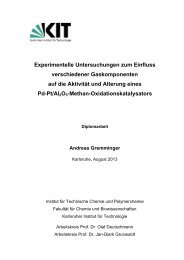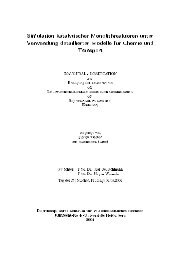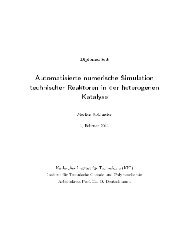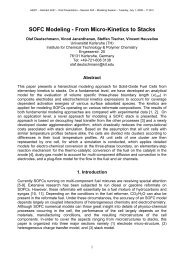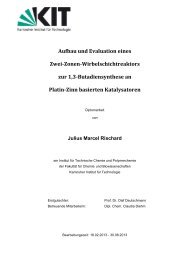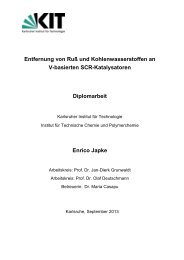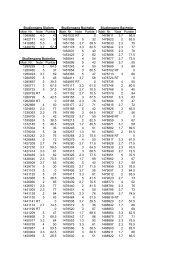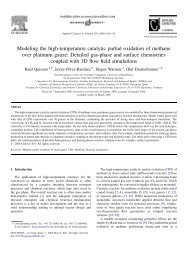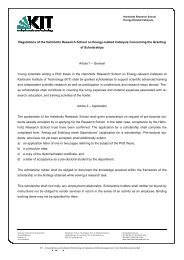Fuel Processing for Fuel Cells - Institut für Technische Chemie und ...
Fuel Processing for Fuel Cells - Institut für Technische Chemie und ...
Fuel Processing for Fuel Cells - Institut für Technische Chemie und ...
You also want an ePaper? Increase the reach of your titles
YUMPU automatically turns print PDFs into web optimized ePapers that Google loves.
Author's personal copy<br />
<strong>Fuel</strong> <strong>Processing</strong> <strong>for</strong> <strong>Fuel</strong> <strong>Cells</strong> 51<br />
independently of any direct influence of the catalytic surface, which<br />
means radicals are not recombined on the surface <strong>for</strong> z>1 mm. However,<br />
both heterogeneous and homogeneous chemistries are coupled, because<br />
the resulting carbonaceous overlayer on the catalyst is a result of the<br />
composition of gas phase near the channel wall. The exact position of this<br />
C(s) layer is rather sensitive to small variations of several physical parameters<br />
such as reactor temperature, catalyst loading, flow rate, and diffusion<br />
models. Furthermore, it always occurs in the first third of the catalyst<br />
at a given C/O ratio and is very typical <strong>for</strong> the rich regime, as observed<br />
experimentally (Figure 16) (Hartmann, 2009). First studies indicate that<br />
the catalyst still shows some activity in that region. A recent AFM study<br />
(Essmann, 2011; Essmann et al., 2011) of the initial state of coking in hightemperature<br />
re<strong>for</strong>ming led to the conclusion that coke <strong>for</strong>mation indeed<br />
starts at the catalyst particle and then spreads over the support. However,<br />
the mechanism of coke <strong>for</strong>mation very much depends on the local conditions<br />
and temperature. Three different kinetic regimes have recently been<br />
observed in high-temperature re<strong>for</strong>ming of hydrocarbons, two initiated by<br />
the catalytic particle, and one by deposition from the gas phase at higher<br />
temperatures and at a much larger rate (Schädel, 2008).<br />
7.2.2 Quantitative model prediction of <strong>for</strong>mation of coke precursors<br />
in the gas phase<br />
The olefins <strong>for</strong>med in the gas phase have a particularly high potential to<br />
<strong>for</strong>m soot particles further downstream of the catalyst, because it will be<br />
difficult to cool down the hot product fast enough to avoid any further<br />
gas-phase reactions, and there<strong>for</strong>e, molecular growth of olefins to PAHs<br />
will occur. The <strong>for</strong>med particles are a definite threat <strong>for</strong> other devices such<br />
6.3 nm<br />
Carbon<br />
0.42 nm<br />
Rh<br />
Rh<br />
0.22 nm<br />
Al 2 O 3 support<br />
Figure 16 Coke <strong>for</strong>mation on the inner catalytic channel walls and TEM image of<br />
carbon-covered Rh particle after the honeycomb was used <strong>for</strong> several hours in a CPOX<br />
reactor operated with iso-octane as feed at C/O>1.0. Pictures are taken from Hartmann<br />
(2009).



